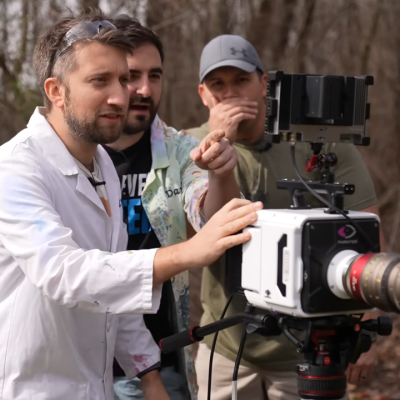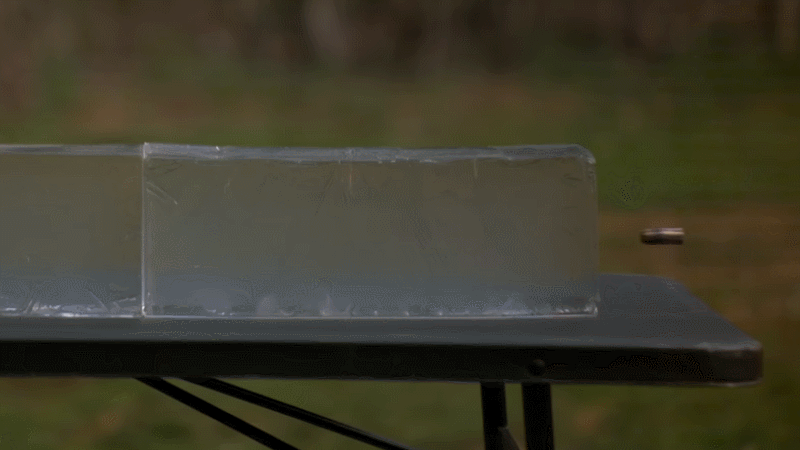[The Slo Mo Guys] caught something fascinating while filming some firearms at 82,000 frames per second: a visible emission of light immediately preceding a bullet impact. The moment it occurs is pictured above, but if you’d like to jump directly to the point in the video where this occurs, it all starts at [8:18].
The ability to capture ultra-slow motion allows us to see things that would otherwise happen far too quickly to perceive, and there are quite a few visual spectacles in the whole video. We’ll talk a bit about what is involved, and what could be happening.

First of all, the clear blocks being shot are ballistic gel. These dense blocks are tough, elastic, and a common sight in firearms testing because they reliably and consistently measure things like bullet deformation, fragmentation, and impact. It’s possible to make homemade ballistic gel with sufficient quantities of gelatin and water, but the clear ones like you see here are oil-based, visually clear, and more stable (they do not shrink due to evaporation).
We’ve seen the diesel effect occur in ballistic gelatin, which is most likely the result of the bullet impact vaporizing small amounts of the (oil-based) gel when the channel forms, and that vaporized material ignites due to a sudden increase in pressure as it contracts.
In the video linked above (and embedded below), there is probably a bit more in the mix. The rifles being tested are large-bore rifles, firing big cartridges with a large amount of gunpowder igniting behind each bullet. The burning powder causes a rapid expansion of hot, pressurized gasses that push the bullet down the barrel at tremendous speed. As the bullet exits, so does a jet of hot gasses. Sometimes, the last bits of burning powder are visible as a brief muzzle flash that accompanies the bullet leaving the barrel.
A large projectile traveling at supersonic velocities results in a large channel and expansion when it hits ballistic gel, but when fired at close range there are hot gasses from the muzzle and any remaining burning gunpowder in the mix, as well. All of which help generate the kind of visual spectacles we see here.
We suspect that the single frame of a flashlight-like emission of light as the flat-nosed bullet strikes the face of the gel is also the result of the diesel effect, but it’s an absolutely remarkable visual and a fascinating thing to capture on film. You can watch the whole thing just below the page break.

















My guess would be sonoluminescence due to dissolved gas, but could be the “Argon Bomb” type flash seen when explosives compress air or argon gas.
It could be related to the generation of xrays from sellotape too. further studies on the types of radiation present would shed more light.
😊
A penetrating insight, to be sure!
I thought about that also. An interesting test would be to use a sharp, pointed bullet instead of the flatter nosed one they used. At the same bullet velocity, I wonder if the sharp pointed bullet would also produce a flash, but from a much smaller point. My guess is the angle of the “cone” of light produced at impact is directly related to the bullet velocity.
X-rays from tape, I did not see that one coming, so I googled a bit and found this video:
https://youtu.be/LQBjRF9mX1Y
Fascinating stuff.
Interesting.
Thanks!
I saw this yesterday, if you watch the whole video, just before the bullet hits the second block you will see the light again from the transition to the second block. It again may be the diesel effect between the blocks.
The second flash between the two blocks makes me think diesel as well. I built a super sonic ping pong ball cannon a while ago and when hitting some surfaces there is a similar flash. As far as I can tell the ball burns with the compressed air between it and the surface.
Mach 1.3 ball vs. Ping Pong Paddle: https://i.imgur.com/UvHREt0.mp4
Femtophotography(which this isn’t, really) is an amazing thing. I particularly was impressed by the capture of light propagating through a water-filled vessel. Amazing.
This needs to be repeated with a diffraction grating and then in an inert atmosphere.. or even an oxygen enriched one :-p
I wonder if having the blocks of ballistic gel farther away from the rifle muzzle would make a difference regarding the flash of light.
That second shot with the lead also.looks a bit like a fleshlight.
A merging of fetishes. Both are masturbation toys.
I mean, they even giggled.